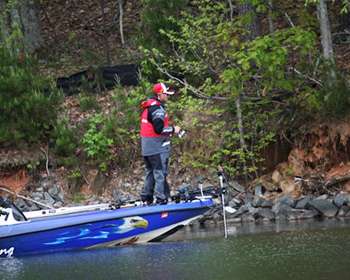
Riprap banks are prevalent on many lakes across the country.
According to Elite Series pro Terry Butcher, when water temperatures begin to dip as summer comes to an end, it's hard to find a better place to load the boat with aggressive bass.
"To me, the fall is one of the best times of year to fish riprap," he said. "The bass are in transition, and the shad and baitfish will congregate on riprap to feed on the algae and plankton that are growing on the rocks."
When fishing a new body of water, Butcher says that starting on a riprap bank is one of the best options for catching numbers of bass. These areas can be made even sweeter with the presence of current or moving water.
"With a few good rain showers, you have current flowing under bridges that are lined with riprap and it will position the bass tight to the rocks," he said.
If he is fishing a long stretch of riprap that all looks the same, Butcher pays close attention to his electronics to locate a sweet spot where the bass will gang up.
"I'll look for a channel swing that comes close to the bank or an old river channel that parallels the riprap. Any variation like that can become a key area."
After locating a key area, the most important step is to put the bait in front of a bass. In most cases, Butcher says that this requires good boat control and a long cast parallel to the riprap bank.
"I like to position my boat right up against the bank and parallel the shore," he said. "The whole key is getting your bait to make contact with the rock."
Butcher explains that the bass will sit several feet off the riprap bank and face the shore, looking to ambush shad that are feeding in inches of water. A well-placed cast will generate a reaction bite from bass lying in wait. Butcher's lure selection for riprap banks is fairly simple. Starting out, he prefers fast moving baits like buzzbaits and shallow crankbaits.
These baits generate a reaction strike and identify key areas where bass are holding. After getting a few bites, he will go back through the area and pick it apart with a slower presentation like a Texas rigged Yum Wooly Bullee.
"Most of the time you'll catch a lot more fish if they're hitting a moving bait," he says. "If I feel like there are fish in the area, or if I'm getting a lot of short strikes, I'll turn around and go back down the bank with a flipping bait."
While the Elite Series schedule hasn't allowed Butcher to take advantage of this pattern in recent years, he remembers numerous tournaments early in his career where the fall riprap bite paid dividends.
"I can remember really catching them on riprap on lakes like Eufaula in Oklahoma. It's a solid pattern where you can move around the lake and catch fish wherever you find riprap."
(Provided by Z3 Media)




